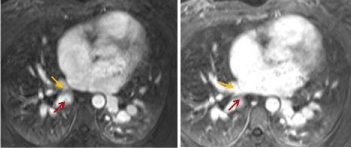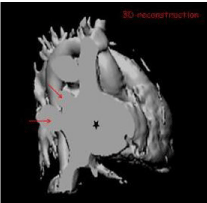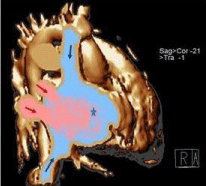Clinical Image
The Contribution of 3-Dimentinal Magnetic Resonance Imaging in Congenital Cardiac Abnormalities
Nikolaos G Baikoussis1*, Panagiotis Dedeilias1, Theodoros Kratimenos2, Eftsathia Prappa3 and Michalis Argiriou1
1Department of Cardiovascular and Thoracic Surgery, Evangelismos General Hospital of Athens, Greece
2Department of Interventional Radiology, Evangelismos General Hospital of Athens, Greece
3Department of Cardiology, Evangelismos General Hospital of Athens, Greece
*Corresponding author: Nikolaos G. Baikoussis, Department of Cardiovascular and Thoracic Surgery, Evangelismos General Hospital of Athens, 45-47 Ipsilantou Street, Kolonaki, Athens, Greece
Published: 28 Mar, 2017
Cite this article as: Baikoussis NG, Dedeilias P, Kratimenos
T, Prappa E, Argiriou M. The
Contribution of 3-Dimentinal Magnetic
Resonance Imaging in Congenital
Cardiac Abnormalities. Clin Surg. 2017;
2: 1367.
Clinical Image
The atrial septal defect (ASD) is a common congenital abnormality with wide variety of its anatomy. When the indication for surgical occlusion exists, cardiac surgeon has to know preoperatively the exact defect and the position of the pulmonary veins. With the use of the 3D MRI, the mapping of the interatrial septum and the identification of the anatomic surrounding structures is feasible. In this paper we would like to show the fantastic 3D MRI images. We show the defect and the exact position of the pulmonary veins. In the international bibliography has been proposed many imaging modalities in this issue. Transthoracic Echocardiography and Cardiac Magnetic Resonance Imaging [1-3], are proposed for many authors is this setting. The 3-D transoesophageal echocardiography [4] and the use of multidetector computed tomography assessment are also applied in order to better recognize the abnormalities [5]. The ASD account approximately 13% of congenital cardiac abnormalities, with a range of prevalence from 1.6 to 1.8 of 1000 live births. There are five major types of ASD which include the secundum and primum types, sinus venosus and coronary sinus defects, and patent foramen ovale [6]. These defects are often undiagnosed at birth. It often can be found incidentally on routine imaging. Understanding their type, size, location, and presence or absence of other congenital defects is paramount in determining the appropriate therapy [6]. The majority of ASD is usually operated on median sternotomy other than the percutaneous closure. This decision is based on some parameters of the defect, like its size, its shape, and the location with respect to the surrounding tissue [6]. In this imaging paper we would like to show some interesting pictures taken with the use of the 3D MRI. In Figure 1 with the yellow arrow is seen the right superior pulmonary vein. The red arrow shows the right inferior pulmonary vein. As seen in this image, the origin of these two veins is in extreme vicinity. Figure 2 is an MRI with 3D reconstruction. Red arrows: superior and inferior right pulmonary veins. Star: right atrium. Finally the Figure 3 is another MRI; 3D reconstruction. Star: right atrium with mixed arterial (pink) and venous (blue) blood. The two blue arrows: venous blood coming from the superior and inferior vena cava. Red arrows: arterial blood coming from the pulmonary veins.
Figure 1
Figure 1
with the yellow arrow is seen the right superior pulmonary vein. The red arrow shows the right inferior
pulmonary vein. As seen in this image, the origin of these two veins is in extreme vicinity.
Figure 2
Figure 2
An MRI with 3D reconstruction. Red arrows: superior and inferior right pulmonary veins. Star: right atrium.
Figure 3
Figure 3
MRI; 3D reconstruction. Star: right atrium with mixed arterial (pink)
and venous (blue) blood. The two blue arrows: venous blood coming from
the superior and inferior vena cava. Red arrows: arterial blood coming from
the pulmonary veins.
References
- Mojadidi MK, Tobis JM. Patent Foramen Ovale and Atrial Septal Defect: Utility of Alternative Imaging Modalities for the Diagnosis of Patent Foramen Ovale and Atrial Septal Defect. Echocardiography. 2015;32:1451-2.
- Mousa TM, Akinseye OA, Kerwin TC, Akinboboye OO. A Rare Association of Sinus Venosus-Type Atrial Septal Defect and Persistent Left Superior Vena Cava Detected by Transthoracic Echocardiography and Cardiac Magnetic Resonance Imaging. Am J Case Rep. 2015;16:528-31.
- Chan FP, Hanneman K. Computed tomography and magnetic resonance imaging in neonates with congenital cardiovascular disease. Semin Ultrasound CT MR. 2015;36:146-60.
- Aubry P, Brochet E, Verdonk C, Dilly MP, Juliard JM. 3-D transoesophageal echocardiography guidance in percutaneous closure of three distant atrial septal defects. Eur Heart J Cardiovasc Imaging. 2015;16:1045.
- Hoey ET, Lewis G, Yusuf S. Multi detector CT assessment of partial anomalous pulmonary venous return in association with sinus venosus type atrial septal defect. Quant Imaging Med Surg. 2014;4:433-4.
- German C, Nanda NC. Three-dimensional echocardiographic assessment of atrial septal defects. Ann Card Anaesth. 2015;18:69-73.



